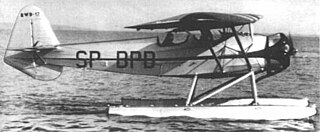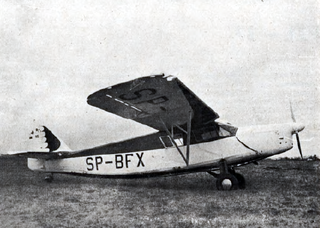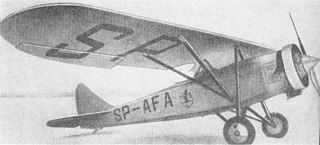The LWS-6 Żubr was a twin-engined medium bomber designed and produced by the Polish aircraft manufacturer LWS. It was only produced in limited numbers and was used for training purposes as it proved to be inferior to the contemporary PZL.37 Łoś medium bomber.

The RWD 5 was a Polish touring and sports plane of 1931, a two-seat high-wing monoplane, constructed by the RWD team. It was made famous by its transatlantic flight, being the smallest aircraft to cross the Atlantic.
RWD was a Polish aircraft construction bureau active between 1928 and 1939. It started as a team of three young designers, Stanisław Rogalski, Stanisław Wigura and Jerzy Drzewiecki, whose names formed the RWD acronym.

The RWD 8 was a Polish parasol wing monoplane trainer aircraft produced by RWD. It was used from 1934 to 1939 by the Polish Air Force and civilian aviation.

The Lublin R-XIII was the Polish army cooperation plane, designed in the early-1930s in the Plage i Laśkiewicz factory in Lublin. It was the main army cooperation plane in the Invasion of Poland. Its variant Lublin R-XIV was a military trainer aircraft.

Lubelska Wytwórnia Samolotów was a Polish aerospace manufacturer, located in Lublin, created in 1936 from Plage i Laśkiewicz works and produced aircraft between 1936 and 1939.

The LWS-3 Mewa ("Seagull") was a Polish observation and close reconnaissance aircraft, designed in the late-1930s by the LWS factory. It was ordered by the Polish Military Aviation, but did not manage to enter service before the outbreak of World War II.

The LWS-2 was the Polish air ambulance aircraft prototype, designed in the late-1930s in the LWS factory.

The RWD 17 was a Polish aerobatics-trainer aircraft of 1937, parasol wing monoplane, constructed by the RWD team.
The following is the order of battle of the Polish Air Force prior to the outbreak of the Polish Defensive War of 1939. During the mobilization waves of March and August of that year, all peace-time units were deployed to airfields throughout the country and attached to respective commands of Air Force, Naval Air Service and squadrons supporting each of the Polish armies. In the last stages of the air campaign, whole units coordinated all actions in the fight against the invaders.

The RWD 13 was a Polish touring plane of 1935, three-seater high-wing monoplane, designed by the RWD team. It was the biggest commercial success of the RWD.

The RWD-15 was a Polish touring aircraft of 1937, designed by the RWD team and built by the Doświadczalne Warsztaty Lotnicze (DWL).

The PWS-26 was a Polish advanced training aircraft, used from 1937 to 1939 by the Polish Air Force, constructed in the PWS. It was the second most numerous Polish pre-war aircraft, after the RWD-8.

The PWS-24 was a Polish single-engine passenger aircraft for 4 passengers, built in PWS factory, used from 1933 to 1936 by LOT Polish Airlines. In spite of its limited capacity, it was the only series-built airliner of domestic design ever used by the LOT.
The Lublin R-XX was the Polish torpedo bomber floatplane, designed in the early 1930s in the Plage i Laśkiewicz factory in Lublin. It remained a prototype.

The PZL Ł.2 was a Polish Army cooperation and liaison aircraft, built in 1929 in the Polskie Zakłady Lotnicze (PZL) in Warsaw. Only a small series of 31 aircraft, including prototype, were made, and used by the Polish Air Force in the 1930s. The aircraft was known in Poland for accomplishing of a long-distance tour around Africa in 1931.
Doświadczalne Warsztaty Lotnicze (DWL) was the Polish aircraft manufacturer, active in 1933-1939. It was a home of the RWD construction team and manufactured aircraft under a brand RWD.

The RWD 16bis and RWD 21 were Polish two-seat low-wing touring and sports planes of the late 1930s, constructed by the RWD bureau, sharing the same construction, main difference of the RWD 21 being a stronger engine.
RWD 22 was a Polish twin-engine torpedo bomber and naval reconnaissance floatplane design. Developed by Leszek Dulęba and Andrzej Anczutin of Doświadczalne Warsztaty Lotnicze in 1939, the project was to be developed under the brand of the RWD design bureau. The outbreak of World War II interrupted the design and it never left the planning stage.
The army cooperation aircraft was an inter-war concept of an aircraft capable of support of ground units in a variety of roles. Army cooperation planes combined the roles of artillery spotter aircraft, liaison, reconnaissance plane and close air support.














